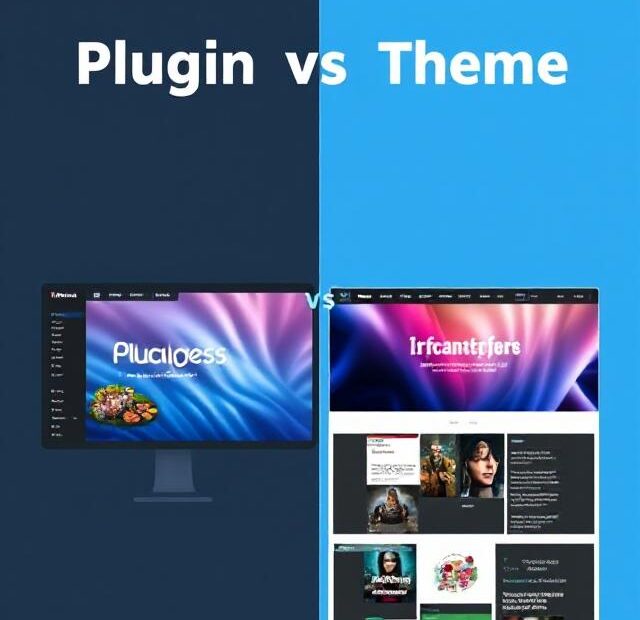When building or customizing a website, you’ve probably heard of WordPress plugins and themes. While both are essential to creating a functional and visually appealing site, they serve very different purposes. Many beginners confuse them, sometimes installing the wrong tool for the wrong job. To avoid that mistake, it’s crucial to understand the WordPress Plugin vs Theme debate in detail.
In this guide, we’ll break down what each one does, their differences, and how they work together.
What Is a WordPress Theme?
A WordPress theme is essentially your website’s outfit. It controls the way your site looks, including:
-
Layout – where menus, sidebars, and content appear
-
Colors & Fonts – the typography and color schemes
-
Design Elements – styling for buttons, forms, and images
Themes can be free or premium. Some themes are very minimal, while others are “multi-purpose” with built-in customization tools. Examples include Astra, GeneratePress, and Divi.
Themes focus mainly on appearance, but some modern themes come with extra functionality. However, heavy reliance on theme-specific features can limit you if you decide to switch themes later.
What Is a WordPress Plugin?
A WordPress plugin is like an app for your website. Plugins add new features or enhance existing functionality without changing your site’s overall design.
Examples of plugin functions:
-
Contact forms (Contact Form 7, WPForms)
-
SEO optimization (Yoast SEO, Rank Math)
-
E-commerce capabilities (WooCommerce)
-
Security enhancements (Wordfence)
Plugins range from small utilities to complex systems. You can install as many as you need, but adding too many can slow down your website.
WordPress Plugin vs Theme: The Main Differences
Let’s break down the differences in a clear comparison table:
| Feature | WordPress Theme | WordPress Plugin |
|---|---|---|
| Purpose | Controls the look/design | Adds or enhances functionality |
| Impact | Affects layout, colors, fonts | Adds features without changing design |
| Customization | Limited to design settings | Can change how the site works |
| Examples | Astra, OceanWP, Divi | Yoast SEO, WPForms, WooCommerce |
Simply put:
-
Use a theme to change your site’s appearance.
-
Use a plugin to add or modify features.
Can a Theme Act Like a Plugin?
Sometimes, yes—but it’s risky. Some themes come bundled with features like sliders, forms, or SEO tools. While convenient, it can create problems if you switch to another theme, because those built-in features often disappear.
Best practice: Keep design and functionality separate. Use your theme for styling and plugins for extra features.
Choosing the Right Theme
When selecting a theme:
-
Keep it lightweight – Faster themes improve SEO and user experience.
-
Check mobile responsiveness – More than half of web traffic is mobile.
-
Look for customization options – So you can make it your own without coding.
-
Test compatibility – Ensure it works well with your essential plugins.
Choosing the Right Plugins
When adding plugins:
-
Install only what you need – Too many can slow your site down.
-
Read reviews and check updates – Outdated plugins can cause security risks.
-
Prioritize essential functions – SEO, backups, and security are must-haves.
-
Check compatibility – Some plugins may conflict with your theme or other plugins.
Do Plugins and Themes Work Together?
Absolutely. In fact, they need each other. A theme sets the stage visually, while plugins give your website the features it needs. For example:
-
Your theme controls your store’s layout.
-
A plugin like WooCommerce actually powers the e-commerce functionality.
SEO Impact: Plugins vs Themes
From an SEO standpoint:
-
A lightweight, fast-loading theme improves page speed—critical for rankings.
-
SEO plugins like Rank Math or Yoast help optimize content, meta tags, and sitemaps.
The combination of a well-coded theme and the right plugins is key to SEO success.
Common Mistakes to Avoid
-
Overloading your site with too many plugins.
-
Choosing a bloated theme with unnecessary built-in features.
-
Relying solely on the theme for functionality.
-
Ignoring updates—both themes and plugins need regular updates for security.
Final Thoughts
The WordPress Plugin vs Theme distinction is simple once you break it down:
-
Themes = design
-
Plugins = functionality
A well-designed site uses a clean, responsive theme for appearance and a curated set of plugins for features. Keep them separate, updated, and compatible to ensure your site runs smoothly.
By understanding how they work together, you’ll avoid compatibility issues, improve site speed, and create a better experience for your visitors.
If you want, I can also make you a Yoast SEO–optimized Word version of this post so it’s ready to publish directly in WordPress with headings, readability scoring, and focus keyphrase integration.
Also, you can learn more about Ultimate Guide to PPC Campaign here.
